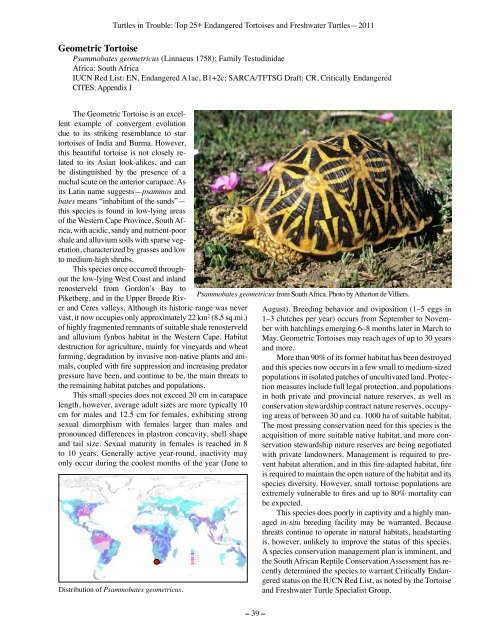Turtles in Trouble: The World's 25+ Most Endangered - Wildlife ...
Turtles in Trouble: The World's 25+ Most Endangered - Wildlife ...
Turtles in Trouble: The World's 25+ Most Endangered - Wildlife ...
- No tags were found...
Create successful ePaper yourself
Turn your PDF publications into a flip-book with our unique Google optimized e-Paper software.
<strong>Turtles</strong> <strong>in</strong> <strong>Trouble</strong>: Top <strong>25+</strong> <strong>Endangered</strong> Tortoises and Freshwater <strong>Turtles</strong>—2011Geometric TortoisePsammobates geometricus (L<strong>in</strong>naeus 1758); Family Testud<strong>in</strong>idaeAfrica: South AfricaIUCN Red List: EN, <strong>Endangered</strong> A1ac, B1+2c; SARCA/TFTSG Draft: CR, Critically <strong>Endangered</strong>CITES: Appendix I<strong>The</strong> Geometric Tortoise is an excellentexample of convergent evolutiondue to its strik<strong>in</strong>g resemblance to startortoises of India and Burma. However,this beautiful tortoise is not closely relatedto its Asian look-alikes, and canbe dist<strong>in</strong>guished by the presence of anuchal scute on the anterior carapace. Asits Lat<strong>in</strong> name suggests—psammos andbates means “<strong>in</strong>habitant of the sands”—this species is found <strong>in</strong> low-ly<strong>in</strong>g areasof the Western Cape Prov<strong>in</strong>ce, South Africa,with acidic, sandy and nutrient-poorshale and alluvium soils with sparse vegetation,characterized by grasses and lowto medium-high shrubs.This species once occurred throughoutthe low-ly<strong>in</strong>g West Coast and <strong>in</strong>landrenosterveld from Gordon’s Bay toPiketberg, and <strong>in</strong> the Upper Breede Riverand Ceres valleys. Although its historic range was nevervast, it now occupies only approximately 22 km 2 (8.5 sq.mi.)of highly fragmented remnants of suitable shale renosterveldand alluvium fynbos habitat <strong>in</strong> the Western Cape. Habitatdestruction for agriculture, ma<strong>in</strong>ly for v<strong>in</strong>eyards and wheatfarm<strong>in</strong>g, degradation by <strong>in</strong>vasive non-native plants and animals,coupled with fire suppression and <strong>in</strong>creas<strong>in</strong>g predatorpressure have been, and cont<strong>in</strong>ue to be, the ma<strong>in</strong> threats tothe rema<strong>in</strong><strong>in</strong>g habitat patches and populations.This small species does not exceed 20 cm <strong>in</strong> carapacelength, however, average adult sizes are more typically 10cm for males and 12.5 cm for females, exhibit<strong>in</strong>g strongsexual dimorphism with females larger than males andpronounced differences <strong>in</strong> plastron concavity, shell shapeand tail size. Sexual maturity <strong>in</strong> females is reached <strong>in</strong> 8to 10 years. Generally active year-round, <strong>in</strong>activity mayonly occur dur<strong>in</strong>g the coolest months of the year (June toDistribution of Psammobates geometricus.Psammobates geometricus from South Africa. Photo by Atherton de Villiers.August). Breed<strong>in</strong>g behavior and oviposition (1–5 eggs <strong>in</strong>1–3 clutches per year) occurs from September to Novemberwith hatchl<strong>in</strong>gs emerg<strong>in</strong>g 6–8 months later <strong>in</strong> March toMay. Geometric Tortoises may reach ages of up to 30 yearsand more.More than 90% of its former habitat has been destroyedand this species now occurs <strong>in</strong> a few small to medium-sizedpopulations <strong>in</strong> isolated patches of uncultivated land. Protectionmeasures <strong>in</strong>clude full legal protection, and populations<strong>in</strong> both private and prov<strong>in</strong>cial nature reserves, as well asconservation stewardship contract nature reserves, occupy<strong>in</strong>gareas of between 30 and ca. 1000 ha of suitable habitat.<strong>The</strong> most press<strong>in</strong>g conservation need for this species is theacquisition of more suitable native habitat, and more conservationstewardship nature reserves are be<strong>in</strong>g negotiatedwith private landowners. Management is required to preventhabitat alteration, and <strong>in</strong> this fire-adapted habitat, fireis required to ma<strong>in</strong>ta<strong>in</strong> the open nature of the habitat and itsspecies diversity. However, small tortoise populations areextremely vulnerable to fires and up to 80% mortality canbe expected.This species does poorly <strong>in</strong> captivity and a highly managed<strong>in</strong>-situ breed<strong>in</strong>g facility may be warranted. Becausethreats cont<strong>in</strong>ue to operate <strong>in</strong> natural habitats, headstart<strong>in</strong>gis, however, unlikely to improve the status of this species.A species conservation management plan is imm<strong>in</strong>ent, andthe South African Reptile Conservation Assessment has recentlydeterm<strong>in</strong>ed the species to warrant Critically <strong>Endangered</strong>status on the IUCN Red List, as noted by the Tortoiseand Freshwater Turtle Specialist Group.– 39 –







![RaLand / SeaScape [PDF] - Wildlife Conservation Society](https://img.yumpu.com/49974326/1/190x245/raland-seascape-pdf-wildlife-conservation-society.jpg?quality=85)








